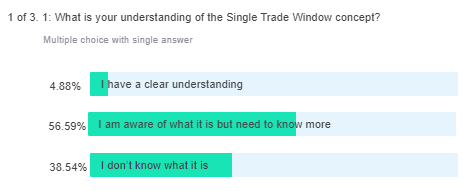
The government is designing a Single Trade Window for the UK, a new facility that will allow traders to input all data relating to imports and exports in one place, rather than through multiple systems run by different border agencies and authorities.
Phillip Stansfield, a deputy director on the UK’s Single Trade Window programme, told an Institute of Export & International Trade (IOE&IT) webinar yesterday (14 February) that the new portal is being delivered to “encompass everything you need to do to interact with government”.
“At the heart of our ambitions is simplification,” he said. “Our aim is to make the lives of government departments and traders easier, giving you more time for what really matters which is running your business.”
‘Single entry point’
The UN Centre for Trade Facilitation and Electronic Business defines a Single Trade Window as a “facility that allows parties involved in trade and transport to lodge standardised information and documents with a single entry point to fulfil all import, export, and transit-related regulatory requirements”.
The UK is looking to deliver its own programme as part of its 2025 UK Border Strategy. It is expected to be designed “iteratively” with full functionality reached by 2027, Stansfield said.
Single Trade Windows are already in operation around the globe, including in the US, Singapore and Kenya.
Benefits
On the webinar, Kevin Shakespeare, director of strategic partnerships and international development at the IOE&IT, said the new programme could “reduce delays and supply chain costs” for businesses.
“Because you are entering through a Single Trade Window, this eliminates the need to submit the same data to different government authorities – it’s just one set of data,” he said.
“It also provides potential for pre-population of data based on previous entries,” he added. “This could be beneficial for repeat consignments, for example”.
Stansfield said government is “adopting a ‘tell us once’ approach, where a trader will not be asked for the same data multiple times”.

‘Legislative challenges’
However, Stansfield did admit there could be “legislation challenges” integrating multiple systems in one place – including those used for agrifoods, excise and military products.
“We may run into legislative stumbling blocks which will mean that there will be exclusions that have to drop out of it,” he said.
“It’s fundamental that DEFRA, APHA and other bodies are key stakeholders in the Single Trade Window,” said Shakespeare.
Stansfield also noted that data privacy and compliance with GDPR will be a “key requirement” for the programme.
Consulting trade on STW design
The government previously extended the deadline of a public consultation, asking for industry views on what the UK’s Single Trade Window programme could look like, to midday on 28 February.
The IOE&IT also ran a survey, on behalf of the Cabinet Office, through which it collected views from its members to present an aggregated response to the government.
The deadline for responses had been extended to close of play on Friday 18 February, but is now closed.
The IOE&IT is hosting a webinar next Monday (24 October), where two panels of experts will discuss the Single Trade Window and will answer questions from traders.
You can register here for free.
Awareness of STW
However, on the webinar, only 5% of attendees said they had a clear understanding of what a Single Trade Window is.
Two fifths (39%) said they had no understanding of the concept, with over a half (57%) saying they had some understanding but needed to know more.

HMRC takes charge
On the webinar, Stansfield explained that although the design of the programme has so far been conducted within the Cabinet Office, it is currently being moved into the remit of HMRC.
“We are as a programme in a transition. We’re moving from the Cabinet Office – where we’ve been doing strategic planning and having conversations with ministers – into HMRC, which will be the delivery directorate,” he said.
“This is primarily to benefit from the infrastructure which a department of that size, that’s used to doing digital delivery of this scale, has to offer.”



